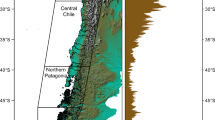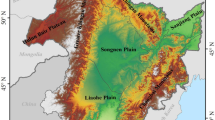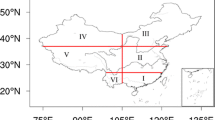Abstract
Projected changes in summer precipitation characteristics in China during the 21st century are assessed using the monthly precipitation outputs of the ensemble of three “best” models under the Special Report on Emissions Scenarios (SRES) A1B, A2, and B1 scenarios. The excellent reproducibility of the models both in spatial and temporal patterns for the precipitation in China makes the projected summer precipitation change more believable for the future 100 years. All the three scenarios experiments indicate a consistent enhancement of summer precipitation in China in the 21st century. However, the projected summer precipitation in China demonstrates large variability between sub-regions. The projected increase in precipitation in South China is significant and persistent, as well as in North China. Meanwhile, in the early period of the 21st century, the region of Northeast China is projected to be much drier than the present. But, this situation changes and the precipitation intensifies later, with a precipitation anomaly increase of 12.4%–20.4% at the end of the 21st century. The region of the Xinjiang Province probably undergoes a drying trend in the future 100 years, and is projected to decrease by 1.7%–3.6% at the end of the 21st century. There is no significant long-term change of the projected summer precipitation in the lower reaches of the Yangtze River valley. A high level of agreement of the ensemble of the regional precipitation change in some parts of China is found across scenarios but smaller changes are projected for the B1 scenario and slightly larger changes for the A2 scenario.
Similar content being viewed by others
References
Bueh, C., 2003: Simulation of the future change of East Asian monsoon climate using the IPCC A2 and B2 scenarios. Chinese Science Bulletin, 48(10), 1024–1030. (in Chinese)
Cook, K. H., and E. K. Vizy, 2006: Coupled model simulations of the West African monsoon system: 20th century simulations and 21st century predictions. J. Climate, 19, 3681–3703.
Ding, Y. H., and Coauthors, 2006: National assessment report on climate change, part I: historical climate change and future trends in China. Advances in Climate Change Research, 2(1), 3–8. (in Chinese)
Ding, Y. H., Z. Y. Wang, and Y. Sun, 2008: Inter-decadal variation of the summer precipitation in East China and its association with decreasing Asian summer monsoon. Part I: Observed evidences. International Journal of Climatology, 28(9), 1139–1161.
Gao, X. J., Y. Shi, R. Song, F. Giorgi, Y. Wang, and D. Zhang, 2008: Reduction of future monsoon precipitation over China: Comparison between a high resolution RCM simulation and the driving GCM. Meteor. Atmos. Phys., 100, 73–86, doi: 10.1007/s00703-008-0296-5.
Gillett, N. P., F. W. Zwiers, A. J. Weaver, G. C. Hegerl, M. R. Allen, and P. A. Stott, 2002: Detecting anthropogenic influence with a multi-model ensemble. Geophys. Res. Lett., 29(20), 1970, doi: 10.1029/2002GL015836.
Giorgi, F., and Coauthors, 2001: Emerging patterns of simulated regional climatic changes for the 21st century due to anthropogenic forcings. Geophys. Res. Lett., 28(17), 3317–3320.
Gong, D. Y., and C. H. Ho, 2002: Shift in the summer rainfall over the Yangtze River valley in the late 1970s. Geophys. Res. Lett., 29, doi: 10.1029/2001GL014523.
Guo, Q. Y., J. N. Cai, X. M. Shao, and W. Y. Sha, 2003: Interdecadal variability of East-Asian summer monsoon and its impact on the climate of China. Acta Geographica Sinica, 58(4), 569–576. (in Chinese)
Hu, Z.-Z., S. Yang, and R. Wu, 2003: Long-term climate variations in China and global warming signals. J. Geophys. Res., 108(D19), 4614, doi: 10.1029/2003JD003651.
IPCC, 2001: Climate Change 2001: The Scientific Basis. Contribution of Working Group I to the Third Assessment Report of the Intergovernmental Panel on Climate Change. Cambridge University Press, UK, 944pp.
IPCC, 2007: Regional Climate Projections. Climate Change 2007: The Physical Science Basis. Contribution of Working Group I to the Fourth Assessment Report of the Intergovernmental Panel on Climate Change, Cambridge University Press, Cambridge, United Kingdom and New York, NY, USA, 884pp.
Jiang, D. B., H. J. Wang, and X. M. Lang, 2004a: East Asian climate change trend under global warming background. Chinese Journal of Geophysics, 47(4), 590–596. (in Chinese)
Jiang, D. B., H. J. Wang, and X. M. Lang, 2004b: Multi-model ensemble prediction for climate change trend of China under SRES A2 scenario. Chinese Journal of Geophysics, 47(5), 776–784. (in Chinese)
Kimoto, M., 2005: Simulated change of the East Asian circulation under global warming scenario. Geophys. Res. Lett., 32, L16701, doi: 10.1029/2005GL023383.
Kripalani, R. H., J. H. Oh, and H. S. Chaudhari, 2007: Response of the East Asian summer monsoon to doubled atmospheric CO2: Coupled climate model simulations and projections under IPCC AR4. Theor. Appl. Climatol., 87, 1–28, doi: 10.1007/s00704-006-0238-4.
Kusunoki, S., J. Yoshimura, H. Yoshimura, and A. Noda, 2006: Change of baiu rain band in global warming projection by an atmospheric general circulation model with a 20-km grid size. J. Meteor. Soc. Japan, 84(4), 581–611.
Li, S., 2008: Projecting the summer climate of mainland China in the middle 21st century: will the droughts in North China persist? Atmos. Oceanic Sci. Lett., 1, 12–17.
Lu, R. Y., 2003: Linear relationship of interannual and interdecadal rainfall in North China. Chinese Science Bulletin, 48(7), 718–722. (in Chinese)
Min, S. K., S. Legutke, A. Hense, U. Cubasch, W. T. Kwon, J. H. Oh, and U. Schlese, 2006: East Asian climate change in the 21st century as simulated by the coupled climate model ECHO-G under IPCC SRES scenarios. J. Meteor. Soc. Japan, 84(1), 1–26.
Shi, Y. F., Y. P. Shen, D. L. Li, G. W. Zhang, Y. J. Ding, R. J. Hu, and E. Kang, 2003: Discussion on the present climate change from warm-dry to warmwet in Northwest China. Quaternary Sciences, 23, 152–164. (in Chinese)
Sun, Y., S. Solomon, A. G. Dai, and R. W. Portmann, 2007: How often will it rain? J. Climate, 20, 4801–4818.
Taylor, K. E., 2001: Summarizing multiple aspects of model performance in a single diagram. J. Geophys. Res., 106(D7), 7183–7192.
Wang, H. J., 2001: The weakening of Asian monsoon circulation after the end of 1970s. Adv. Atmos. Sci., 18(3), 376–386.
Wang, H. J., 2002: The instability of the East Asian summer monsoon-ENSO relations. Adv. Atmos. Sci., 19(1), 1–11.
Wang, H. J., Q. C. Zeng, and X. H. Zhang, 1992: Simulated climate change due to double CO2. Science in China (B), 6, 663–672. (in Chinese)
Wei, J., Q. Y. Zhang, and S. Y. Tao, 2003: Characteristics of atmospheric circulation anomalies during persistent droughts in North China for last two decades. Journal of Applied Meteorological Science, 14(2), 140–151. (in Chinese)
Xu, Y., Y. H. Ding, and Z. C. Zhao, 2003: Scenario of temperature and precipitation changes in Northwest China due to human activity in the 21st century. Journal of Glaciology and Geocryology, 25(3), 327–330. (in Chinese)
Yu, R. C., and T. J. Zhou, 2007: Seasonality and three-dimensional structure of the interdecadal change in East Asian monsoon. J. Climate, 20, 5344–5355.
Zhang, L., Y. H. Ding, and Y. Sun, 2008: Evaluation of precipitation simulation in East Asian monsoon areas by coupled Ocean-Atmosphere General Circulation Models. Chinese J. Atmos. Sci., 32(2), 261–276. (in Chinese)
Zhao, Z. C., S. W. Wang, and Y. Luo, 2007: Assessments and projections of temperature rising since the establishment of IPCC. Advances in Climate Change Research, 3(3), 183–184. (in Chinese)
Author information
Authors and Affiliations
Corresponding author
Rights and permissions
About this article
Cite this article
Chen, H., Sun, J. How the “best” models project the future precipitation change in China. Adv. Atmos. Sci. 26, 773–782 (2009). https://doi.org/10.1007/s00376-009-8211-7
Received:
Revised:
Published:
Issue Date:
DOI: https://doi.org/10.1007/s00376-009-8211-7




